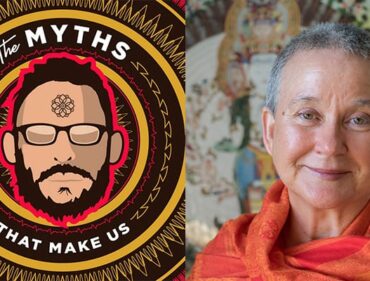Article: To Weave a New World: Shamanic and Tantric Practice
By Isa Gucciardi, Ph.D.
To enter the world of Tantra is to enter a world beyond the ordinary. Through a series of catalytic processes, the spiritual seeker is drawn along a path that promises nothing less than the revelation of the nature of reality. This is a promise that also lies at the heart of shamanic practice. Yet the ‘reality’ that reveals itself when the shamanic initiate steps beyond the threshold of ordinary awareness is conceived of differently than that of Tantra.
The reality that is the focus of Tantra lies in the understanding of the human mind. The reality that is understood through shamanic practice emerges through an intimate interface with the unseen powers of the natural world. These two realities are not exclusive from one another, but the thrust and focus of these two practices are at least initially different.
Both systems provide stages of development to educate the initiate as they deepen their understanding about the nature of reality. These stages of development constitute the heart of the practices. Let’s explore these wisdom traditions further and deepen our understanding of how these two paths cross and separate in the process of providing an education about the nature of reality.
Tantra in Vajrayana Buddhist practice has its roots in Indian religious philosophy. As Buddhism emerged out of the Vedic and Hindu systems, it went through its own set of evolutionary processes. Buddhist tantras first appeared in India around 400 CE and they found their way into Buddhist practice in many areas of Asia. Today, Buddhist tantras are found in all the Tibetan lineages, and also in the Japanese Buddhist school of Shingon.
The practice of Tantra is based on the foundational teachings of Buddhism, but focuses on practices which employ mental and physical energies to develop spiritual understanding in a way that reaches beyond the fundamentals of Buddhist thought. Tantric practices focus on working with sound, movement, ceremony, and elemental and subtle energies.
Shamanism is a system of knowledge based on an intimate relationship with the natural world, including the unseen powers that are understood to reside within the physical forms of nature. Unlike the more localized practice of Tantra in the Himalaya, the practice of earth-based wisdom is found around the world. There are many forms and foci of shamanic practice, but we find essential elements shared in settings separated by time and space. Here, we are focusing on compassionate forms of shamanic practice.
The practice of earth-based wisdom focuses on the use of sound, movement, ceremony, and subtle energies. Shamans work with practices related to these elements to heal, to divine, and to use subtle processes to affect change on the material level as they serve their communities. The goals of shamanic practice do not, however, necessarily lie in the attainment of enlightenment. Rather, the evolution of the shamanic initiate is focused on an ever-deepening relationship with the powers of the earth and the natural world.
Most Tantric and shamanic processes take place in non-ordinary states of awareness that lie beyond the usual conscious mind awareness, which is primarily focused on problem-solving. These non-ordinary states allow the seeker to move beyond ordinary ways of knowing, opening doors to the broader mind lying beyond the narrower focus of the conscious mind. In Tantra, the altered state of awareness is attained through an ever-deepening meditative focus that begins with the stabilization of attention and awareness through samatha meditation, and further evolves through the processes of inner inquiry in Vipassana meditation techniques. This inner focus further deepens through deity meditation, in which the meditator merges with the field of deities that embody aspects of higher awareness: compassion (Avaloketishvara); healing (Medicine Buddha); and wisdom (Manjushri). There are many deities within the Tantric system, and each of them provide important education about the nature of reality to the initiate who steps into their stream of intelligence.
In shamanism, non-ordinary states of consciousness are also a fundamental part of practice. These states are attained in a variety of ways, including through sound, dance, movement, and the ingestion of psychotropic plants. The focus on repetitive sound, most commonly a drum, is one of the most widespread methods of altering awareness, particularly through the practice of the shamanic journey. The inner cosmography of the shamanic initiate is not unlike that of the Tantric initiate. It, too, is characterized by the presence of fields of compassionate intelligence transcendent in nature, and provides progressive teachings that help develop the initiate’s capacities. In shamanic practice, these fields of intelligence take the forms of nature (such as the spirit of a star, a plant or animal), who guide the student’s path toward deeper understanding of the processes of nature. The ability of the shaman to fill with the power of these guides directly correlates to their capacity to perform tasks such as ministering and doctoring. The process of power filling is not unlike that of merging with the deity in deity meditation. Further, in both systems, the altered states of dreaming, visionary experience, and mediumship are important sources and channels of information in the deepening of the initiate’s understanding of the nature of reality. These practices are also guided and mediated by these same compassionate fields of intelligence.
In both Tantric and shamanic practice, teachings regarding transformation are key to understanding the nature of reality. The initiate comes to know themselves and the nature of worlds around them and within them more intimately through understanding the processes of transformation. Most of the teaching the deities in Tantra or the guides in shamanism convey is through the process of transformation. The initiate is put through different processes of change to broaden their understanding.
In both sets of processes, the work taking place on the inner planes is mediated by compassionate forms of guidance. They mediate transformation and changes in state by generating catalytic processes in and around the initiate. This can include the direction and focus of light, sound, elements, and other subtle energies into both mental and physical forms to catalyze change.
There are many aspects of experience these two wisdom systems embrace and many methods of transformation and transmutation they include. The perception and comprehension of the way transmutation functions is the course of study both systems offer.
Let’s look at how this transmutation of awareness functions in the development of consciousness within Tantra through the process of deity meditation with the meditation deity, Avaloketishvara. Avaloketishvara is often called the Buddha of Infinite Compassion. The visual representation in art, often in thangkas, paintings traditionally drawn on silk, provides education about the nature of any deity in Tibetan Buddhism. This understanding can also be gained through direct realization in meditation, but not all meditators can find their way into the field of the deity without the instruction the images contained in thangkas provide.
In the case of Avaloketishvara, the depiction of the thousand-armed, eleven-headed deity is at once a primer and an advanced treatise on the nature of compassion. The thousand arms, whose hands each have an eye in the center of the palm, indicate the deity’s capacity to perceive suffering in a thousand places at once. The tools held in the inner ring of the arms closest to the deity’s body indicate all the ways in which suffering can be effectively addressed. One hand holds a sword that cuts through delusion, another holds a rope that binds the initiate to their vows, another holds the herb that heals all wounds. The eleven heads indicate the deity’s capacity to exercise this kind of activity in eleven realms at once. This is just the beginning of an elucidation of the many qualities of Avaloketishvara.
This is a deity that all students of the Tantra seek to understand. Here is an account of one of my meditations with this deity that demonstrates the way in which the transmutative nature of these practices help develop the initiate.
I spent some time in samatha meditation honing my attention and awareness, then stepped into Vipassana meditation through the request for assistance to deepen my capacity to understand compassion. Then I moved into a merge with the field of the deity by lining up my subtle energy system with the subtle energy system of the deity through the help of light and sound. As I did this, I found myself in an almost overwhelming experience of clarity.
I felt the deity ‘grab’ my attention, and I was told telepathically to focus on the eleven heads. I was told to practice holding awareness in eleven realms at once. The effort to attain this instruction had an imploding effect on my ability to maintain awareness of my personal perspective. I was challenged again and again to let go of anything that would keep me from being able to maintain the merge with the deity and continue my efforts to simply be aware of the eleven realms.
We were not talking about holding compassion for the thousands of forms of suffering in them – just to hold awareness of the eleven realms. This is a meditation that I did almost daily for the better part of a year before I had the ability to even imagine being able to hold that awareness of the eleven realms without being overwhelmed. During that time, I had to undergo multiple transformative processes in related Vipassana meditation to shift my relationship and understanding of compassion, the nature of suffering, and the nature of deliverance, in order to be able to hold my awareness in the eleven realms at once.
During these meditations, I worked with sound (mantras and prayers), light (focusing clear light into the places which could not hold awareness), the elements (working with the element of earth in particular to hold and focus my attention), and ceremony and ritual (I lit candles and cleared the space where I meditated). The transformation in this process is a transformation of consciousness. It is intrapsychic. In this case, the focus on transformation is on the initiate’s capacity to broaden awareness.
The processes of deepening and focusing awareness with a goal toward transformation is also part of shamanic practice. Initiates are often called to the path through a vision or dream which instantly focuses their awareness into the deeper workings of non-ordinary reality. These visions or dreams are often mediated by a field of intelligence which provides a teaching through the vision or dream. Black Elk, an Oglala Lakota leader and shamanic practitioner who was born in the late 1800’s, recounts such a vision in the book, Black Elk Speaks:
It was the summer when I was nine years old, and our people were moving slowly towards the Rocky Mountains. We camped one evening in a valley beside a little creek just before it ran into the Greasy Grass and there was a man by the name of Man Hip who liked me and asked me to eat with him in his tepee.
While I was eating, a voice came and said: It is time; now they are calling you. The voice was so loud and clear that I believed it, and I thought I would just go where it wanted me to go. So, I got right up and started.
In the book, Black Elk goes on to describe an encounter with elders in non-ordinary reality who provided him with a vision for the future of his people. This vision was a turning point, providing a seminal initiation into the shamanic path. The elders he encountered in the vision guided, taught, and informed him throughout his life.
This deepening and focusing of attention into non-ordinary reality can also take place in a less ‘intrusive’ way through the practice of the shamanic journey. Here is an account of a shamanic journey in which the same elements that inform Tantric practice are present, but focused in a different way. Again, these elements include the direction and focus of light, sound, elements, and other subtle energies into both mental and physical forms to catalyze change.
In this journey, I altered my state of awareness through beating a drum in a regular, steady beat. My intention in this journey was to offer some help to the animals who were being affected by the fires in Northern California. Specifically, I had the intention to journey to land I knew well near Lassen National Park as I stepped into the non-ordinary cosmography. In the journey, I connected with my shamanic teachers and guides. I had formed relationships with them over a period of many years in different journeys where I was seeking to understand the nature of shamanic healing processes such as soul retrieval and power retrieval. These two forms of healing restore power when someone has been exposed to harm over a period of time (power retrieval), or who has experienced a powerful trauma (soul retrieval). I had received much training in these processes from these guides as I worked to help others who needed assistance.
These teachers took the form of hawks and tigers. I greeted them in the journey, and they indicated that they would help me as I went to offer assistance to the spirits of the animals who had been affected by the fires. Soon, we came to the land where the fires were. I made offerings to the spirit of the land and sat with my guides. The spirit of the land emerged from the large flat lava rocks. It had a powerful, steady presence. I asked if there was anything we could do to assist.
Telepathically, I was told to align with the hope of the possibility of renewal, to not fall into alignment with the forces of despair. So, I sat in circle with my guides, and we held these intentions. Soon, the guides and the spirit of the land began singing, first softly and slowly, and then more loudly. There were many songs. There were songs for the souls of the animals, and songs for the healing of their bodies. We sang these songs for a long time. They were bringing the healing of power retrieval and soul retrieval to the animals. As my heart called to the spirits of the animals who were so terribly affected by the fires, I heard the spirit of the land tell me to hold trust for the regenerative powers of the earth.
Then the songs shifted, and the songs began to call the spirit of the waters from beneath the stones. There were many rounds of songs for the return of water in all forms – from springs, from rain, from snow, from the rebirth of rivers on the land. As the guides and the spirit of the land were singing, some were dancing. I was asked to create an altar representing all the elements – earth, water, air, fire, space – and to make offerings to the weather spirits. I created an altar with a bowl of water, a feather, a candle, a stone, and a star. I made offerings of rose petals and tobacco.
The ceremony of offering and the creation of the altar were designed to bring balance to the elements within the natural environment on the land and to create an opening for the weather spirits to bring the elements that were needed in the form of weather. I drummed for a long time until I felt a shift in the energy of the land. I returned from the journey.
Later that day, I set an altar in ordinary reality that was identical to the one I was asked to set in the journey. Each day I have been saying prayers and singing the same songs we all sang together in the journey, calling healing for the animals and the land. In this case, we work with sound (using the drum to alter my awareness and working with song to carry and focus transformative subtle energies), the elements (the calling of the waters), ritual and ceremony (I created an altar and ceremony), and we focused subtle energies into mental forms to facilitate change in physical forms.
In both examples, the work with sound, light, elements, ritual, and ceremony provides the context and the structure to support the teaching about transformative processes. Both sets of processes take place on inner planes which are accessed differently, but which support and make the perception of phenomena in the transformation process possible. In the Tantric practice, the focus is ‘intrapsychic’ and on the development of inner spiritual evolution. In the shamanic process, the focus is ‘inter-psychic,’ in that the initiate’s focus is directed into the processes of the earth in the intention of healing others.
The paths to understanding these two wisdom systems have much in common in spite of their difference in focus. They work with the processes of transformation to initiate the seeker into the wisdom they curate. They both work with sound, movement, ceremony, and elemental and subtle energies. They both weave new ways of knowing and being, to heal and to inspire, and to create new worlds of possibility.
LIKE THIS ARTICLE? SIGN UP FOR FREE UPDATES!



